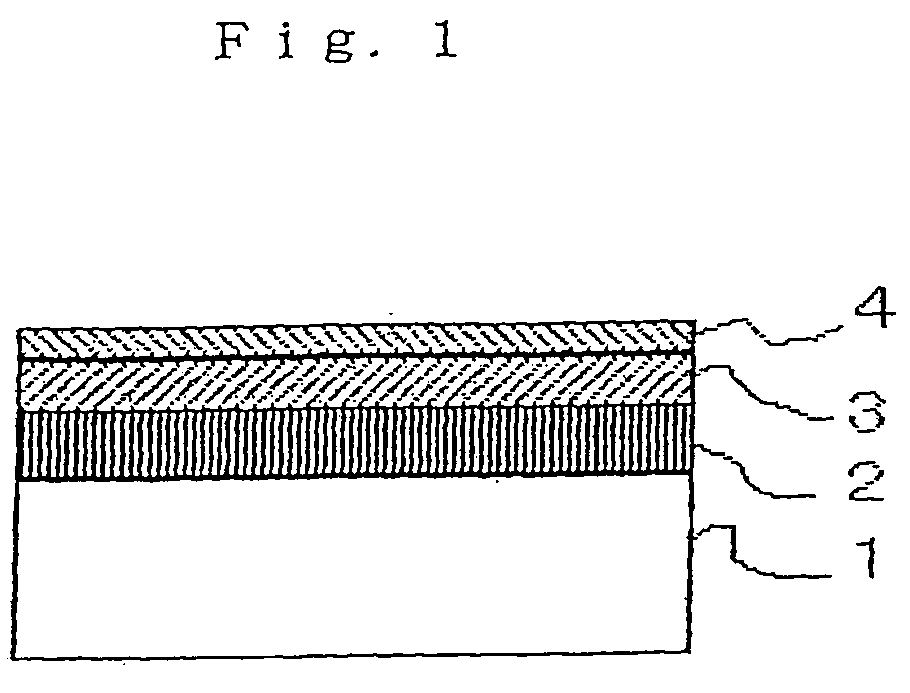Perfluoropolyether compound and lubricant and magnetic disk using same
a technology of perfluoropolyether and compound, which is applied in the field of perfluoropolyether compound and lubricant and magnetic disk using same, can solve the problems of low compatibility of x-1p with perfluoropolyether, failure to form uniform lubrication layer, and production of disks coated with lubricant, so as to reduce the scattering degree of lubricant, inhibit the decomposition of lubricant, and high speed
- Summary
- Abstract
- Description
- Claims
- Application Information
AI Technical Summary
Benefits of technology
Problems solved by technology
Method used
Image
Examples
example 1
[0050] Synthesis of (HOCH2CH2)2N—CH2CF2O(CF2CF2O)m-(CF2O)n-CF2CH2—N(CH2CH2OH)2 [Compound 1)
[0051] Mixed together with stirring were perfluoropolyether having hydroxyl group at an end, i.e. Fomblin Z-DOL (10.0 g) produced by Ausimont S.p.A., pyridine (8.7 g), dimethylaminopyridine (1.8 g) and dichloromethane (50 ml). Trif luoromethanesulf onic acid anhydride (13.9 g) was slowly added. The mixture was continuously stirred at room temperature for 48 hours. After the terminal point of the reaction was confirmed by NMR, the stirring was terminated. Thereafter perf luorohexane (90 ml) was added to the obtained reaction mixture. Then the mixture was washed with a mixed solution of dichloromethane and ethanol. Perfluorohexane was removed by distillation, whereby the contemplated triflate (10.3 g) was produced. The triflate (10.0 g) thus prepared and diethanolamine (8.0 g) were continuously stirred at 105° C. for 48 hours. The terminal point of the reaction was confirmed by NMR and heating ...
example 2
[0055] Synthesis of compound having piperazine ethanol at an end [Compound 2]
[0056] The triflate (10.0 g) prepared by the method described in Example 1 and 1-piperazine ethanol (6.5 g) were continuously stirred at 105° C. for 48 hours. The terminal point of the reaction was confirmed by NMR, and the heating and stirring were terminated. Then Vertrel XF (30 ml) was added to the obtained reaction mixture. The mixture was washed with a mixed solution of water and methanol. Vertrel XF was removed by distillation, whereby the contemplated Compound 2 (7.2 g) was produced.
[0057] The chemical structure of Compound 2 was confirmed by NMR as done in Example 1.
[0058]1H-NMR (solvent: perfluorohexane, reference material: tetramethylsilane): δ=2.4 ppm [8H, Rf-[CF2CH2—N═(CH2CH2)2═N—CH2CH2OH]2], 2.4 ppm [4H, Rf-[CF2CH2—N═(CH2CH2)2═N—CH2CH2OH]2], 2.8 ppm [8H, Rf-[CF2CH2—N═(CH2CH2)2═N—CH2CH2OH]2], 3.6 ppm [4H, Rf-[CF2CH2—N═(CH2CH2)2═N—CH2CH2OH]2], 4.0 ppm [4H, Rf-[CF2CH2—N═(CH2CH2)2═N—CH2CH2OH]2], ...
example 3
[0060] Synthesis of (HOCH2CH2)2N—CH2CF2O(CF2CF2O)m-(CF2O)n-CF2CH2-OH [Compound 3]
[0061] The triflate (10.0 g) prepared by the method described in Example 1 and diethanolamine (4.0 g) were continuously stirred at 105° C. for 48 hours. The terminal point of the reaction was confirmed by NMR, and the heating and stirring were terminated. Then Vertrel XF (30 ml) was added to the obtained reaction mixture. The mixture was washed with a mixed solution of water and methanol. After purification by column chromatography, Vertrel XF was removed by distillation, thereby giving the contemplated Compound 3 (2.0 g).
[0062] The chemical structure of Compound 3 was confirmed by NMR as done in Example 1.
19F-NMR (solvent: none, reference material: OCF2CF2CF2CF2O in the obtained product being taken as −125.9 ppm): δ=−81.3 ppm, −83.3 ppm [2F, Rf-(CF2CH2—OH)], δ=−72.8 ppm, −75.1 ppm [2F, Rf-[CF2CH2—N—(CH2CH2OH)2]], m=10.0 n=11.0
PUM
| Property | Measurement | Unit |
|---|---|---|
| Fraction | aaaaa | aaaaa |
| Fraction | aaaaa | aaaaa |
| Fraction | aaaaa | aaaaa |
Abstract
Description
Claims
Application Information
 Login to View More
Login to View More - R&D
- Intellectual Property
- Life Sciences
- Materials
- Tech Scout
- Unparalleled Data Quality
- Higher Quality Content
- 60% Fewer Hallucinations
Browse by: Latest US Patents, China's latest patents, Technical Efficacy Thesaurus, Application Domain, Technology Topic, Popular Technical Reports.
© 2025 PatSnap. All rights reserved.Legal|Privacy policy|Modern Slavery Act Transparency Statement|Sitemap|About US| Contact US: help@patsnap.com

